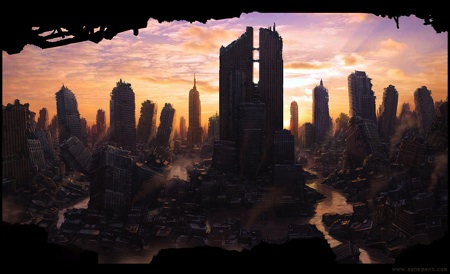Expanding Flexibility
[Translations: Japanese]
There’s no flexibility without life. Without life the primeval world is rigid.
If life itself were to vanish from this planet – not just humans as in the book “The World Without Us” – but all life suddenly gone, the remains of our creations would go rigid as well, and crumble. For many years the rock of our cities would stand tall. Skyscrapers would reach the sky, and suburbs sprawl across the landscape. But in a short while, particularly in the initial oxygen rich atmosphere of the biosphere, metals, plastics, and organics would start corroding. Anything, either living or artificial, that flexes, adapts, bends, or seals is made of a material which becomes rigid left on its own. Rubber goes brittle in air; sealants decay and leak. Iron rusts and expands. Most metals oxidize and flake. Only a few substances like gold remain unaltered over time, but these metals have very limited flexibility.
We use very few inert things, because, well, they are inert. Nearly 100% of what we produce and consume are active in a chemical-physical way. Either life (as in cells) or technology (as in factories) have processed and activated these materials to make them useful. The iron in iron ore is reduced, the carbon in organics is bonded, the other elements combined by judicious application of energy to make the ingredients of our natural biosphere and artificial technosphere. But without maintenance, these flexible materials disappear.

Life obviously rots upon death, but even corrosion-resistant stainless steel and copper embedded in buildings and bridges would over time corrode and fail. Almost any material used to keep water out will, over time, fail. Water, that most corrosive liquid, will then eat any metal or organic material it touches. Concrete and stone crumble when water seeps in. As metals oxidize, hinges seize up. Swelling rust pulverizes concrete further. Moving parts stop. Plastics shred. Silicon seals dry. Everything becomes ossified. Even though the sun continues to shine, and the wind blows, and the waves crash, this surging ocean of energy becomes impotent and wasted on structures that are not flexible. The energy washes over them without positive effect.
It requires the focused, controlled energy in living and technological systems to keep the material world flexible. Metals have to be cleaned, replaced, protected. Organics need to be replenished. Flexibility has to be maintained at a significant energetic cost. If the processes which ensure adaptation, bendability, flexibility fail, then the large cycles of creation, growth and life fail, too.
The world then returns to a cold still, stiff world that can’t capture the flows of energy as they pass by. Minds, too, must remain flexible and bendable to capture the flow of ideas as they stream by.
In the wide vastness of the universe, flexibility is rare. It is not a “natural” state, but must be maintained (ironically) by another flexible agent. Flexibility, whether organic or inorganic, is a sign of life.
Technological systems are flexible, and are a sign of life. One of the things that technology wants is more flexibility: More controlled movement, more ways to move, more kinds of movement, more bendability, more adaptation, more ways to hold an elevated different, more ways to maintain a moving difference of any type.
A dead universe, a life-less planet, or a technology-free zone have none of that. Difference vanishes, controlled movement ceases, flexibility disappears. The only thing that remains are inflexible laws of physics, storms of unharnessed energy, and eternal sameness.
But wherever we see the expansion of flexibility, we see the growth of life and mind.


